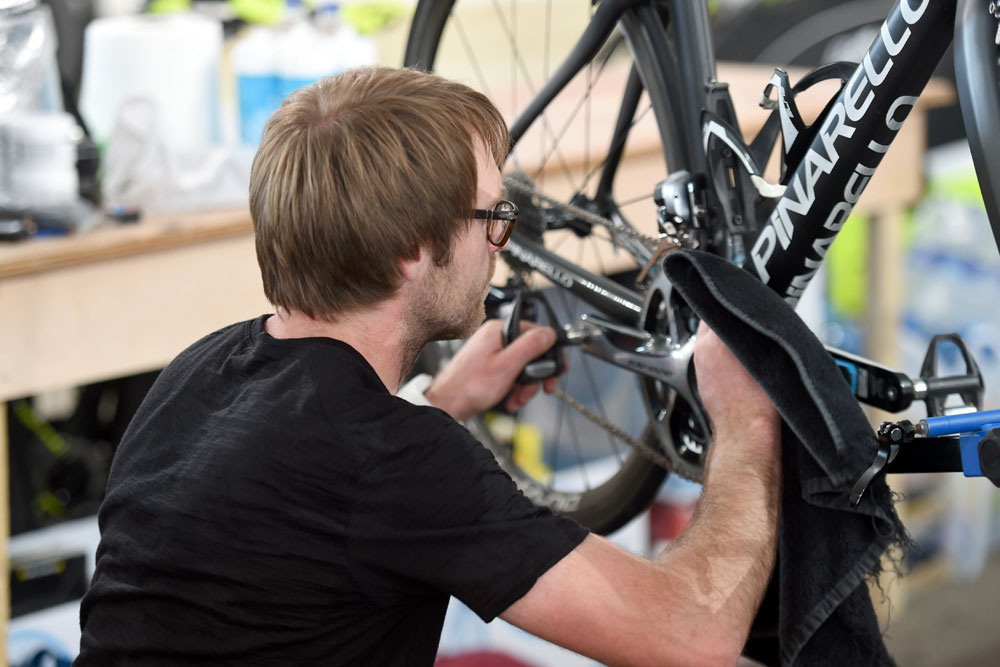5 bike maintenance essentials, and how to better pay attention to your bicycle’s needs
Thoughts on keeping your bike healthy, happy and on the road and the value in getting your hands greasy from time to time.


When you purchase a car, the manufacturer will typically provide maintenance recommendations based on mileage to ensure that it will keep performing safely and consistently over time. Vehicle owners can use these recommendations to decide for themselves whether to have this work done at a dealership or by an independent mechanic of their choosing. Scheduled or mileage-based maintenance prevents issues that could cause harm to passengers or those outside the vehicle.
Bicycles are far less complex than cars, but still require regular maintenance for optimal performance. It’s rare, however, for a bike manufacturer to provide a scheduled maintenance sequence the same way car makers do. Many shops offer a free one-time tune-up with a bike purchase, but after that, customers are left to their own devices to stay on top of service and maintenance, often without much information at their disposal to ascertain the bicycle’s needs.
Longtime riders may be familiar with the upkeep a bicycle requires, but for new and casual riders, there is a bit of a knowledge gap. A good shop will be able to help to inform and educate a customer, while a less scrupulous one could prey on their lack of expertise.
Because there are so many different kinds of riding people do, there are no single “one-size-fits-all” maintenance recommendations that will work for everyone. Everyone rides differently and how to maintain your bike will depend on your location, the type of bike you own, the amount of riding you do, the conditions in which you ride, and more. Thus, there’s a lot of possible variation in what each bike requires.
I’m not going to delve into the nuts and bolts of maintenance here—instead I’m going to offer up some tips for how you can better take care of your bike, without a strict maintenance schedule.
Step 1? Get to know your bike better.
1. Pay attention to your bicycle

You don’t need to know the name of every different bit on your bike, but you should know what a happy, healthy bike sounds like and be able to recognize when something is amiss. You also don’t need to be able to solve the problem when something is creaky or rattely—you can if you want to, but it’s fine to take it to a professional (see #5). Your job is to know your bicycle intimately. Look at it, take pictures of it, listen to it, you can even smell it if you want, the goal is to be familiar with it. Clean it regularly (see #2) and you will soon become acquainted with all of its nooks and crannies and learn which parts go where.
Get The Leadout Newsletter
The latest race content, interviews, features, reviews and expert buying guides, direct to your inbox!
2. Wash your bike often (well, as often as is necessary…)

I don’t always keep my bikes as clean as I should, but it’s because I like to wash them all at once, and I have a few. My drivetrains are always spotless, however, thanks to the wonder of immersion wax and chain rotation, so I’m not too worried about a little road grit on the frame. Sometimes, a bike just needs a wipe-down after riding through a puddle, and sometimes, it requires a full tear-down and rebuild (like after a particularly muddy cyclocross race), but if your bikes are clean, then you can make sure nothing’s broken and easily monitor wear and tear.
3. Keep a maintenance log

This one is easy enough: find an old notebook or journal, or else create one digitally, and use it to keep track of the maintenance you’ve done. This is particularly useful for things like chain swaps, brake bleeds, tyre replacements and the like. Trust me, if you don’t write it down, you will forget when you last swapped cassettes and how many miles you've got on your chain.
Keeping notes becomes even more critical when you own multiple bikes. This allows you to refer back to previous maintenance and recognize patterns and potential chronic issues. I also highly recommend keeping a longer to-do list of bike tasks in your workshop, it could be in the same notebook or on a whiteboard on the wall, but writing things down is always worthwhile.
4. Strava can track your bike's mileage

If you aren’t accustomed to doing bike upkeep based on feel, then there are a few ways you can stay on top of it with digital tools. One of these is with calendar alerts: putting bike maintenance into your calendar system of choice offers a helpful reminder so you don’t end up with a catastrophic mechanical failure. You could put in an alert to check drivetrain wear once a month on Saturday, for instance, or to bleed your brakes (or swap brake cables) annually at the start of each year.
If you are a Strava user, you can use the platform to track mileage on individual bikes and even individual components. This can be done by going into “My Gear” in the “Settings” menu and then clicking on each bike listed. At the bottom of the page is a section titled “Components” where the software allows you to choose from a drop-down menu, add parts to each bike listed, and track mileage for each one separately.
5. Build a rapport with your local shop

Hopefully, you have a local bike shop where you live, and if you live somewhere with many shops to choose from, count yourself lucky! Stop in, say hello, and drop off cold seltzer waters on hot days. Most importantly, buy stuff from them. You want the mechanics at the shop to be a) happy to see you, and b) happy to help you out in a pinch. Thus, when you need one single calliper bolt the day before your big riding trip, you have a place to source it from. Even if you’re comfortable doing most of your maintenance at home, it’s still good to have a place for those times when you need an expensive tool to fix something or get too busy to finish a task. A good bike mechanic is worth their weight in gold.
Conclusion

Bike ownership doesn’t neccsarily require getting your hands dirty, but it’s fun to do from time to time. Some people are tinkerers and some aren’t. But if you want to really get to know your bike, then I recommend digging beneath the surface a little bit every now and again.
Everyone on a group ride will appreciate the person who has an extra tyre boot and knows how to use it. It may take years to get comfortable with working on your own bike, or you may decide it’s just not for you—that’s OK! But you still need to know enough to be able to bring it in for service before the wheels fall off. There’s nothing worse than riding with a friend and having them point out that annoying clicking noise that somehow escaped your notice.
It’s up to you to learn what your bike needs based on how and where you ride it. Always keep in mind that regular preventative maintenance is preferable to unscheduled catastrophic failure.

Thank you for reading 20 articles this month* Join now for unlimited access
Enjoy your first month for just £1 / $1 / €1
*Read 5 free articles per month without a subscription

Join now for unlimited access
Try first month for just £1 / $1 / €1

Tyler Boucher is a former (and occasionally still) bike racer across several disciplines. These days, he spends most of his time in the saddle piloting his children around in a cargo bike. His writing has appeared in magazines published in Europe, the UK and North America. He lives in Seattle, Washington.
You must confirm your public display name before commenting
Please logout and then login again, you will then be prompted to enter your display name.